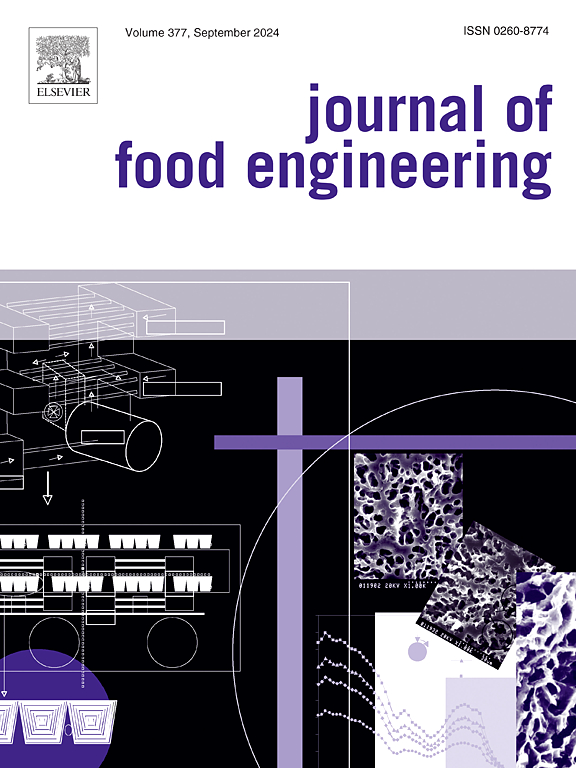Pickering water-in-oil emulsions stabilized by beeswax crystals: Design and stability
IF 5.8
2区 农林科学
Q1 ENGINEERING, CHEMICAL
引用次数: 0
Abstract
The aim of this study was to understand how beeswax can be used to stabilize water-in-oil emulsions and examine the impact of droplet volume fraction on emulsion stability. Pickering water-in-oil (W/O) emulsions were successfully designed using beeswax oleogels (4 wt%) as the sole stabilizer via a facile homogenization approach. The effects of beeswax crystals on the formation, stability, and structural organization of W/O emulsions (containing up to 70 % v/v water) were systematically investigated. Oleogelation reduced the interfacial tension between oil and water from 21 ± 1 mN/m to 14 ± 1 mN/m, enabling beeswax crystals to stabilize emulsions without the need for any synthetic surfactant. X-ray diffraction analysis revealed that beeswax crystals in oleogels exhibited a stable β’ polymorph with orthorhombic packing, maintaining a reduced long-chain spacing from 7.8 nm in pure beeswax to 6.3 nm, which contributed to the stabilization of Pickering W/O emulsions. The emulsions ranged in size (D32) from 8 to 16 μm depending upon the droplet volume fraction and showed no significant change over storage period of 6 weeks. Microscopic observations of the interface demonstrated that emulsion stability was achieved through the synergistic effects of both the Pickering stabilization and bulk network stabilization. This dual stabilization mechanism was further confirmed by thermal cycling experiments and in situ crystallization analysis at the interface as well as rheological measurements showing gel formation at higher volume fractions of droplets. Overall, these findings highlight the potential of beeswax to stabilize W/O emulsions for applications in food and allied soft matter industries.
用蜂蜡晶体稳定的皮克林油包水乳剂:设计和稳定性
本研究的目的是了解蜂蜡如何稳定油包水乳液,并考察液滴体积分数对乳液稳定性的影响。采用蜂蜡油凝胶(4 wt%)作为唯一的稳定剂,通过简便的均质方法,成功地设计了Pickering油包水(W/O)乳液。本文系统地研究了蜂蜡晶体对W/O乳液(含高达70% v/v水)形成、稳定性和结构组织的影响。油凝胶化将油和水之间的界面张力从21±1 mN/m降低到14±1 mN/m,使蜂蜡晶体在不需要任何合成表面活性剂的情况下稳定乳液。x射线衍射分析表明,蜂蜡晶体在油凝胶中呈现稳定的β′多晶,具有正交填料,长链间距从纯蜂蜡的7.8 nm减小到6.3 nm,这有助于皮克林W/O乳液的稳定性。根据液滴体积分数的不同,乳液的尺寸(D32)在8 ~ 16 μm之间,在6周的储存期间没有显著变化。界面的微观观察表明,乳状液的稳定性是通过皮克林稳定和体网络稳定的协同作用实现的。热循环实验、界面处的原位结晶分析和流变学测量进一步证实了这种双重稳定机制,这些测量显示,液滴在更高体积分数的情况下会形成凝胶。总的来说,这些发现突出了蜂蜡在食品和相关软物质工业中稳定W/O乳剂的潜力。
本文章由计算机程序翻译,如有差异,请以英文原文为准。
求助全文
约1分钟内获得全文
求助全文
来源期刊

Journal of Food Engineering
工程技术-工程:化工
CiteScore
11.80
自引率
5.50%
发文量
275
审稿时长
24 days
期刊介绍:
The journal publishes original research and review papers on any subject at the interface between food and engineering, particularly those of relevance to industry, including:
Engineering properties of foods, food physics and physical chemistry; processing, measurement, control, packaging, storage and distribution; engineering aspects of the design and production of novel foods and of food service and catering; design and operation of food processes, plant and equipment; economics of food engineering, including the economics of alternative processes.
Accounts of food engineering achievements are of particular value.
 求助内容:
求助内容: 应助结果提醒方式:
应助结果提醒方式:


